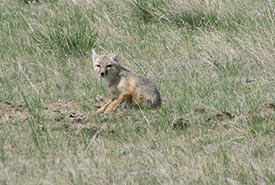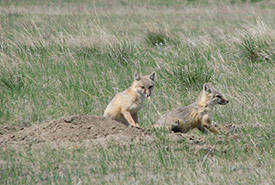NCC: Land Lines – The fun-sized swift fox

Swift fox (Photo by RJ Dudragne/ NCC staff)
My name is Emily, and I am the 2023 communications and engagement summer intern for the Nature Conservancy of Canada (NCC) in Saskatchewan. As part of my job, I get to write stories for Land Lines, NCC’s blog.
For my first assignment, I wanted to shine a light on a species at risk in Saskatchewan that is close to my heart: swift fox. The first time I ever saw a swift fox was at the Saskatoon Forestry Farm when I was 5. There were two of them and they were so small I thought they were babies. I remember them being my favourite and not wanting to leave their enclosure to go look at the other animals. I have loved learning about them and hope you do too.
Swift fox is the smallest member of the canine family found in Canada. While they are only about the size of a housecat, they are extremely agile and can reach speeds of up to 60 kilometres per hour. Their habitat consists of native grasslands, and they can be found in southeast Alberta and southwest Saskatchewan, as well as parts of the United States. Their diet consists mainly of small mammals, but they will also eat birds, eggs, insects, plants and carrion.
Swift fox (Photo by RJ Dudragne/ NCC staff)
This pint-sized fox spends much of its time in the day sunbathing and sleeping, never straying too far from its den. Being nocturnal, it does most of its hunting at night. Swift foxes are an important part of maintaining a diverse ecosystem, as well as ensuring prey populations are kept in balance. Today, swift fox is assessed as threatened under the Species at Risk Act. While there is now a self-sustaining wild population of swift foxes in Canada, that wasn’t always the case. The Canadian population started to decline in the late 1800s for various reasons, most of which were a direct result of settlement. Unsustainable trapping, conversion of native grasslands to farmland and indiscriminate pest control programs wreaked havoc on the Canadian swift fox populations.
These pest control programs included targeted poisoning of predators (e.g. wolves and coyotes), and the destruction of burrows and dens of badgers, prairie dogs and ground squirrels. The loss of the Great Plains wolf led to an increase in coyotes, which are a natural predator of both red and swift foxes. Even though the programs were not specifically targeting the swift fox, they still resulted in the accidental poisonings and the destruction of swift fox dens. In 1978, the species was considered extirpated (locally extinct) in Canada, 40 years after the last sighting in Canada in 1938. The greatest present-day threat is habitat loss, mostly due to agricultural conversion. Accidental poisoning, predation and increased competition for food resources also contribute to the small population.
Captive breeding and re-introduction programs are to thank for the increase in population of swift foxes roaming the Prairies today. Between 1983 and 1997, approximately 932 swift foxes were released into the Canadian Prairies through the work of various conservation organizations, zoos and government programs. Re-introduction plans were so successful that they changed swift foxes’ official status from extirpated to endangered and again to threatened in 2009. The latest estimate, done in 2015, puts the swift fox population at 870 in the Canadian Prairies.
In Saskatchewan, NCC protects almost 5,300 hectares at the Old Man on His Back Prairie and Heritage Conservation Area for many species, including swift fox. Your support helps safeguard endangered grasslands, wetlands and the wildlife that live there. Learn more at conservegrasslands.ca.





